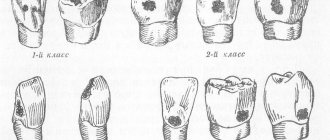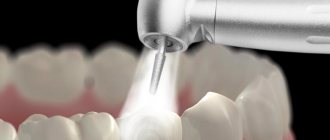Author of the article:
Soldatova Lyudmila Nikolaevna
Candidate of Medical Sciences, Professor of the Department of Clinical Dentistry of the St. Petersburg Medical and Social Institute, Chief Physician of the Alfa-Dent Dental Clinic, St. Petersburg
Caries is a disease that affects all people, regardless of their gender, age and place of residence. Caries is caused by bacteria that settle in the oral cavity due to poor nutrition and poor oral hygiene.
Definition of the concept in dentistry
Deep caries is the last stage of the carious process occurring in the tooth, which is characterized by extensive damage not only to hard tissues, but also to the deep layers of dentin. In general, the concept of “deep caries” reflects the depth of the lesion.
Caries can be:
- primary - a consequence of untreated secondary caries;
- secondary (recurrent) - the occurrence of a carious process under a filling in a previously treated tooth.
Based on the sensation of pain and clinical examination, the disease is divided into 3 forms:
- Acute form. It is determined by the narrow entrance opening of the carious cavity and the wide base (during examination), as well as by descriptions of the patient’s sensations - reaction to food temperature and chemical irritants.
- Chronic form. It is characterized by a wide (funnel-shaped) inlet and a narrow base. The patient feels pain when the “hollow” is clogged with food and during examination with a probe by the dentist.
- Deep cervical caries. It is characterized by the development of demineralization of enamel tissue and the carious process in the cervical area of the tooth (near the gums).
According to the clinical course, caries is also divided into several forms:
- compensated,
- subcompensated,
- decompensated.
Causes of caries development
Oral disease develops under the influence of pathogenic microorganisms that multiply in a favorable environment. Dentists are of the opinion that the disease occurs due to changes in the acid-base balance on tooth surfaces. Fermentation of carbohydrates caused by pathogenic bacteria releases destructive amounts of organic acids.
The main factors that contribute to the formation of carious cavities:
- improper hygiene care;
- eating problems;
- systemic chronic or acute diseases of the gastrointestinal tract;
- reduced concentration of vitamins and minerals in the body;
- hereditary predisposition, etc.
Bacterial plaque and tartar
Streptococci are microorganisms that live in organic acids, leading to the destruction of enamel and dentin. During brushing, soft structures are easily removed, but hardened structures cannot be removed. They also contain pathogens that cause destructive phenomena.
Poor nutrition
Every person knows from an early age that you can’t eat a lot of sweets. However, adults often ignore this rule and consume large amounts of carbohydrates, sugar, baked goods, and starchy foods. The enamel layer becomes thinner and more susceptible to external factors. Bacteria multiply better in a carbohydrate environment.
Decreased salivation
During the day, a person secretes about 2 liters of saliva. The secretion washes away food debris from dental surfaces and protects them from the negative effects of pathogenic microflora. If the salivary glands do not function well enough, a lot of food particles settle on the crowns, which the microbes feed on.
Violation of the mineral composition of enamel
This factor is directly related to diet. Demineralization is observed with a meager, monotonous menu, lack of calcium, phosphorus and fluorine. Seeds, cottage cheese, cheese, red beans, and buckwheat are rich in such microelements.
Genetic predisposition also influences mineralization. This means that the disease can be inherited from parents and other relatives.
The problem occurs in pregnant women at different gestational stages. The fetus takes all the useful minerals, and the expectant mother experiences a lack of them. Subsequent intervention is complicated by the inability to use anesthesia.
Diagnostics
To make a diagnosis, diagnostics are carried out, which include:
- external inspection using a mirror;
- instrumental examination using a probe;
- voicing symptoms (complaints) by the patient;
- thermal diagnostics (checking the reaction to cold and hot);
- electroodontic diagnostics (testing the reaction to exposure to current);
- radiography (performed if the presence of secondary deep caries is suspected or to exclude it).
If upon examination significant damage (destruction) of the tooth crown is detected, expressed by the presence of a deep carious cavity and accompanied by pain during probing, then this confirms the presence of deep caries in the patient.
In the acute form, the carious cavity is filled with light, softened dentin. In chronic deep caries, the walls and bottom of the cavity are filled with a layer of dense pigmented dentin (from brown to black). Percussion of the tooth is not accompanied by pain.
Fluoridation of teeth for children: benefit or harm?
The child’s baby teeth are not yet strong: they have fragile enamel, followed by a thin dentin layer, and at the base there is a soft pulp chamber with nerve endings and blood vessels. Therefore, children's teeth are more easily damaged; caries often forms on them, which can quickly develop into complications. It seems like just yesterday there was a small dark spot on the enamel, and today your child is complaining of severe toothache and refuses to eat.
To reduce the risk of tooth decay, baby teeth need to be cleaned regularly and properly, and strengthened. How can you help your children maintain a beautiful smile and protect them from toothache? With the appearance of the first teeth, bring your child to the dentist for a preventive examination 2-3 times a year. The pediatric dentist will promptly identify possible problems, teach in a playful manner the correct technique for brushing teeth, and also carry out fluoridation that is beneficial for the enamel.
What are the differences from other forms of the disease?
Deep caries is very similar to some forms of the disease, but there are still visible and invisible differences.
Difference from pulpitis
Pulpitis is a complication of advanced caries. The forms of the disease can be distinguished from each other by their characteristic symptoms:
- Defeat. With pulpitis, the nerve is affected; with caries, the nerve remains unharmed.
- Feelings of pain. With pulpitis, pain can occur spontaneously, even without exposure to irritants on the tooth. With caries, pain disappears along with the disappearance of irritants.
- Night sleep. With pulpitis, sleep can be disturbed due to severe pain; with caries, the tooth does not hurt at night.
Difference from average caries
The similarity between the two forms of the disease is that the patient in both forms feels pain from cold, sour or sweet foods. However, with average caries they go away within 1-2 minutes, with deep caries they last longer.
Medium caries is characterized by the fact that in this form the carious lesion does not affect the tooth pulp and does not cause inflammation of the nerve, as in deep caries.
Indications and contraindications
Fluoride varnish coating is a preventive procedure that is suitable for adults and children. Dentists recommend it in the following cases:
- increased sensitivity,
- prevention of caries,
- exposure of the necks of the teeth,
- dental injuries,
- ultrasonic enamel cleaning,
- preparation for prosthetics,
- pregnancy,
- yellow enamel color.
Experts consider the following beneficial properties of fluoride varnish:
- Antibacterial effect - neutralizes bacteria. They lose the ability to process glucose. Thanks to this, acid is not released, which is dangerous for the enamel.
- Strengthening gums - the composition of fluoride varnish has a positive effect not only on enamel, but also on soft tissues. The product nourishes them.
- Restoring enamel - fluoride attracts calcium. The structure of teeth is improved at the molecular level.
- Reduced sensitivity - when the procedure is completed, fluoride varnish forms a strong and hard film on the enamel that is not visible. It reduces the sensitivity of enamel to various irritants: hot and cold, sour and sweet.
- Protection from external factors - extends the life of fillings, slows down the development of diseases.
There are also contraindications to coating teeth with fluoride:
- allergy to the components of the product,
- hypersensitivity to smells and tastes,
- epidemic fluorosis.
Stages of treatment
Treatment of deep caries is impossible without anesthesia (pain relief) and it takes place in several stages.
- Anesthesia. It is carried out using injection (infiltration or conduction) administration of an anesthetic substance.
- Drilling out a carious cavity using a drill. In this way, the specialist can reach and remove all affected areas of dentin, which is very important to prevent relapse under the filling.
- Treatment (disinfection) of the walls of the tooth and the bottom of the cavity.
- Installation of a therapeutic insulating pad and temporary or permanent filling.
- The final stage involves grinding and polishing the filling.
The following factors influence whether a filling will be installed - temporary or permanent:
- at what distance from the pulp is the carious cavity located;
- parameters of dentin, which separates the pulp from the tooth cavity;
- degree of pain.
If there is a high probability of inflammation developing in the pulp area, the dentist will place a temporary filling. And only if there are no complaints of pain and discomfort for several days, the patient will have the temporary filling replaced with a permanent one.
Memo for patients during the treatment of caries.
- Do not drink alcohol before your appointment - this will reduce the effect of anesthesia.
- After the appointment, until the anesthesia wears off, you should not talk much - you can injure the numb tissue.
- You should not eat food within 2 hours after treatment, especially hot food for the same reason.
- After taking it, increased sensitivity may persist for several days, and bleeding gums may occur.
- If after taking it you feel discomfort when biting or pain, consult a doctor immediately.
Deep caries of the front teeth. What are the differences in treatment?
Deep caries of the front teeth should be treated as carefully as possible so as not to burn the pulp. The main difficulty in treatment is:
- minimum thickness of all tooth tissues;
- inconvenient location of the cavity, if we are talking about caries located in the interdental space.
When infection penetrates into the pulp, pulpitis develops rapidly. A few hours is enough. The disease is accompanied by increasing pain. It needs to be treated immediately.
What complications can caries have?
If caries is not treated, its consequences can be not only serious dental diseases:
- pulpitis,
- periodontitis,
- cyst/granuloma,
- abscess/phlegmon,
as a result of which you can easily lose a tooth, but also general diseases of the whole body :
- gastrointestinal diseases, in particular gastritis and stomach ulcers,
- cardiovascular diseases, including infectious myocarditis,
- inflammatory joint diseases,
- allergic reactions.
Is it possible to treat deep caries of a wisdom tooth?
The patient can make the decision to remove a wisdom tooth if pain occurs on his own. But only a highly qualified dentist can make a verdict on its treatment.
Treatment of a carious "eight" is considered rational if it has a partial covering in the form of a hood of gum, as well as an antagonist - the third molar located on the opposite side.
Removal shown:
- with a horizontal tooth position;
- presence or absence of 1st and 2nd molars;
- impossibility of treatment due to incomplete opening of the mouth;
- displacement of teeth in a row due to wisdom teeth.
Treatment at the initial stage is faster and cheaper
When treating caries at the initial stage of its development, anesthesia is not required, since the procedure itself is painless, and the filling will cost less due to the use of a small amount of material. In addition, you will spend much less time: the doctor will fill a small hole in a tooth in 15-30 minutes, while he will have to treat the entire tooth and install a large filling for at least an hour. It all depends on the condition of the dentition and the degree of complexity of the operations performed.
Now you have learned why it is necessary to treat caries, even when your teeth do not hurt. It is possible to prevent serious oral diseases and maintain healthy teeth for many years if you treat your teeth in a timely manner. And one should not neglect the rules of hygiene and preventive examinations at the dentist. The beauty of your smile largely depends on you!
How is caries treated with laser?
Laser treatment of caries is a modern non-contact method. The laser beam passes into the dental tissue to the depth required for treatment. It removes affected tissue, disinfects, and reduces the likelihood of bleeding. At the same time, the laser does not damage healthy tissue.
The advantages of laser treatment of dental caries are the minimal risk of complications, the ability to control the intensity and depth of the effect. With all its advantages, the laser is effective in the early stages of caries, like other non-invasive methods.
What to do if complications have already occurred?
First of all, seek help from a dentist and do not put off visiting him for a day, even if you have already developed caries and are determined to have a tooth removed! Any tooth damaged by caries is a source of infection, which can spread to any area in the oral cavity, trachea or esophagus and cause a number of other diseases. In addition, the sooner you see a doctor, the greater the likelihood that the tooth can be saved.
If the clinic has modern materials and equipment important in the treatment of periodontitis and the treatment of pulpitis, you can count on a high-quality procedure. In particular, diseases such as advanced periodontitis and periostitis can also be cured, but only surgically. In general, traditional treatment consists of removing the nerve, thoroughly cleaning the canals and filling it. However, after such manipulations the tooth becomes more fragile. And do not forget that with the transition to a more complicated stage of caries, the price of its treatment also increases.
Indications for applying fluoride varnish
The range of indications for coating teeth with varnish is quite wide and includes many points. Therefore, almost everyone can use fluoride varnish. Most often, the procedure is performed in the following cases:
- with increased tooth sensitivity,
- for the prevention of caries,
- if there are areas of demineralization on the enamel,
- after ultrasonic teeth cleaning,
- before installing crowns,
- in case of injury.
This procedure has virtually no contraindications. These include only increased sensitivity to components and an excess of fluoride in the body. Teeth can be coated with fluoride varnish as early as 6 years of age. Allergic reactions to the composition of the varnish are extremely rare.
Why is it better to treat caries at the Medikastom dental clinic?
- Many years of experience. The dental clinic has been operating since 2000, successfully providing care to patients even with complex illnesses.
- Highly qualified staff who treat each patient with care and sensitivity.
- First-class equipment and modern drugs.
- Using the latest developments and treatment methods.
- Affordable cost of caries treatment.
- Maximum comfortable conditions for the patient.
- Caries treatment 24/7. Our clinic works for you around the clock, without holidays and weekends, providing qualified assistance when it is most needed.
You can get detailed information on caries treatment by calling us at +7(499) 283-71-58.
Call and sign up for a free consultation right now!
We are waiting for you!











